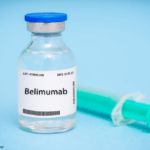 Lupus nephritis is one of the leading causes of mortality for patients with systemic lupus erythematosus (SLE), and patients with both SLE and end-stage renal disease have standardized mortality ratios more than 60 times that of patients with SLE with normal kidney function.1 Lupus nephritis causes irreversible kidney damage and is associated with renal failure, cardiac events and death.2 Treatment is aimed at reducing symptoms, keeping the disease from getting worse and avoiding the disease from getting worse and avoiding the need for dialysis or a kidney transplant.
Lupus nephritis is one of the leading causes of mortality for patients with systemic lupus erythematosus (SLE), and patients with both SLE and end-stage renal disease have standardized mortality ratios more than 60 times that of patients with SLE with normal kidney function.1 Lupus nephritis causes irreversible kidney damage and is associated with renal failure, cardiac events and death.2 Treatment is aimed at reducing symptoms, keeping the disease from getting worse and avoiding the disease from getting worse and avoiding the need for dialysis or a kidney transplant.
The good news: Rheumatologists now have not one, but two approved options to treat patients with active lupus nephritis.
Belimumab Approved
In late December 2020, the U.S. Food & Drug Administration (FDA) approved belimumab (Benlysta) to treat adults with active lupus nephritis who are receiving standard therapy. This approval is for both the intravenous and subcutaneous formulations. Belimumab, which was approved by the FDA to treat SLE in March 2011, is now the first agent approved to treat both SLE and active lupus nephritis in adults.3
This approval addresses an unmet need for lupus nephritis patients and is the result of an FDA breakthrough therapy designation and priority review of findings from the BLISS-LN study.4
Background: BLISS-LN was a phase 3 study conducted in patients with active lupus nephritis (N=448). This randomized, double-blind, placebo-controlled, post-approval commitment study evaluated the efficacy and safety of intravenous belimumab (10 mg/kg dose) and standard therapy (i.e., mycophenolate mofetil for remission induction and remission maintenance, or cyclophosphamide for remission induction followed by azathioprine for remission maintenance, and steroids) compared with placebo and standard therapy in this patient population.
The study’s primary end point was a statistically significant greater number of patients with lupus nephritis taking belimumab and standard therapy achieving a primary efficacy renal response at year 2 (week 104) than patients taking placebo and standard therapy (43% vs. 32%; odds ratio: 95% confidence interval [CI] 1.55 (1.04, 2.32), P=0.0311). Additionally, all four major secondary end points, including complete renal response and time to renal-related events or death, achieved statistical significance. No new safety signals were reported.
BLISS-LN showed that belimumab with standard therapy significantly improves the signs and symptoms of lupus nephritis, and patients had a 49% decrease in the risk of experiencing a renal-related event.
The good news: Rheumatologists now have not one, but two approved options to treat patients with active lupus nephritis.
Voclosporin Also Approved
In January, the FDA approved voclosporin (Lupkynis), a calcineurin inhibitor, to be used in combination with background immunosuppressive therapy to treat adults with active lupus nephritis.5,6 This treatment, which received an FDA fast track designation in 2016, was approved under priority review and is the first FDA-approved oral therapy for lupus nephritis available in the U.S.
In clinical trials, voclosporin demonstrated significantly improved renal response rates compared with mycophenolate mofetil and low-dose steroids. Voclosporin-treated patients were more than twice as likely to have a decline in their urinary protein creatinine ratio than patients on standard therapy alone. Additionally, this improvement occurred twice as fast in voclosporin-treated patients than in patients treated with standard therapy.
Background: The U.S. approval of voclosporin was based on multi-national clinical trials, including the AURORA-1 phase 3 and AURA-LV phase 2 studies.7-9 The AURORA 1 and AURA-LV studies were conducted in similar patient populations and with similar study designs.7 These were double-blind, placebo-controlled, randomized trials comparing two doses of voclosporin (23.7 mg or 39.5 mg twice daily) with patients treated with placebo combined with mycophenolate mofetil (2 grams daily), and rapidly tapered low-dose corticosteroids for induction of lupus nephritis remission. AURORA-1 was conducted over 52 weeks in 357 patients from 27 countries, while AURA-LV was conducted over 48 weeks in 265 patients from 20 countries. The primary end point in both studies was a renal response, which was defined as a urinary protein creatinine ratio of ≤0.5 mg/mg, eGFR ≥60 mL/min, no confirmed decrease from baseline in eGFR of more than 20%, less than 10 mg/d prednisone for at least eight weeks prior to end point assessment and no administration of rescue medication. The urinary protein creatinine ratio was measure in two consecutive, first-morning-void urine specimens.
In AURA-LV, the primary end point was evaluated at week 24 and week 48.8 The renal response at week 24 was attained in 32.6% (n=29) of patients who received 12.7 mg voclosporin twice daily (i.e., the low-dose group) and 27.3% (n=24) of patients who received 39.5 mg voclosporin twice daily (i.e., the high-dose group), compared with 19.3% (n=17) of patients who received placebo (OR=2.03; 95% CI 1.01–4.05; P=0.046). The statistically significant greater renal response in the patients who received low-dose voclosporin was maintained until week 48 (P<0.001 for low-dose voclosporin compared with placebo). Renal response was also significantly more common in the patients who received high-dose voclosporin than in those patients who received placebo at week 48 (P=0.046).
More serious adverse events occurred in patients treated with voclosporin (both doses). Infections and infestations occurred in 12.4% (n=11) of patients who received low-dose voclosporin, in 13.6% (n=12) of patients who received high-dose voclosporin, and in 8% (n=7) of patients who received placebo. !irteen patients died during the study. More deaths occurred in patients who received low-dose voclosporin (n=10; 11.2%) than among patients who received high-dose voclosporin (n=2; 2.3%) and among those patients who received placebo (n=1; 1.1%).
The efficacy results from the AURORA 1 phase 3 study showed that patients treated with voclosporin were consistent with those seen in the AURA-LV study.9 The data showed a renal response in 40.8% of patients treated with voclosporin compared with 22.5% in the control arm, which was statistically significant (P<0.001). The overall incidence of serious adverse events was similar in both groups (voclosporin: 20.8%; control: 21.3%). Infections were the most commonly reported adverse event, at 10.1% with voclosporin and 11.2% in controls. The overall study mortality was low, with one death in the voclosporin arm and five deaths in the control arm.
The most common adverse effects, which occurred in at least 3% of voclosporin-treated patients, were abdominal pain (5%), alopecia (6%), anemia (12%), cough (11%), decreased appetite (3%), diarrhea (19%), dyspepsia (6%), fatigue (4%), headache (15%), hypertension (19% vs. 9% for placebo), mouth ulceration (4%), tremor (3%) and urinary tract infection (10%).5 Adverse effects of particular note included acute kidney injury (3% vs. 1% for placebo), decreased glomerular filtration rate (26% vs. 9% for placebo) and renal impairment (6% vs. 3% for placebo).
Voclosporin’s label carries a boxed warning, stating that patients taking the treatment may have an increased risk for developing lymphomas and other malignancies, particularly of the skin, and serious infections. The risk appears to be related to increasing doses and duration of immunosuppression rather than to the use of any specific agent.6
Michele B. Kaufman, PharmD, BCGP, is a freelance medical writer based in New York City and a pharmacist at New York Presbyterian Lower Manhattan Hospital.
References
- Mok CC, Kwok RC, Yip PS. Effect of renal disease on the standardized mortality ratio and life expectancy of patients with systemic lupus erythematosus. Arthritis Rheum. 2013 Aug;65(8):2154–2160.
- Anders HJ, Saxena R, Zhao MH, et al. Lupus nephritis. Nat Rev Dis Primers. 2020 Jan 23;6(1):7.
- News release: FDA approves GSK’s Benlysta as the first medicine for adult patients with active lupus nephritis in the U.S. GlaxoSmithKline plc. 2021 Dec 17.
- Furie R, Rovin BH, Houssiau F, et al. Two-year, randomized, controlled trial of belimumab in lupus nephritis. N Engl J Med. 2020 Sep 17;383(12):1117–1128.
- News release: FDA Approves Aurinia Pharmaceuticals’ Lupkynis (voclosporin) for adult patients with active lupus nephritis. Aurinia Pharmaceuticals Inc. 2021 Jan 22.
- Highlights of prescribing information: Lupkynis (voclosporin) capsules. U.S. Food & Drug Administration. 2021 Jan 22. https://tinyurl.com/yg6mdab6.
- Ginzler EM, Kaplan J, Lisk L, et al. Integrated efficacy of the AURORA 1 and AURA-LV trials confirms voclosporin rapid proteinurea reduction in the presence of low-dose steroids [abstract 1843]. Arthritis Rheumatol. 2020 Oct;72(suppl 10).
- Rovin BH, Solomons N, Pendergraft WF 3rd, et al. A randomized, controlled double-blind study comparing the efficacy and safety of dose-ranging voclosporin with placebo in achieving remission in patients with active lupus nephritis. Kidney Int. 2019 Jan;95(1):219–231.
- Arriens C, Polyakova S, Adzerikho I, et al. Aurora phase 3 study demonstrates voclosporin statistical superiority over standard of care in lupus nephritis (LN) [abstract OP0277]. Ann Rheum Dis. 2020;79(Suppl 1):172–173.
Breakthrough vs. Fast Track
According to the FDA, breakthrough therapy and fast track designation programs are both intended to expedite the development and review of drugs for serious or life-threatening conditions, but there are differences in what needs to be demonstrated to qualify for the programs.
A breakthrough therapy designation is for a drug that treats a serious or life-threatening condition and preliminary clinical evidence indicates the drug may demonstrate substantial improvement on a clinically significant end point(s) over available therapies.
In contrast, a fast-track designation is for a drug that treats a serious or life-threatening condition, and nonclinical or clinical data demonstrate the potential to address unmet medical needs for the serious condition.


